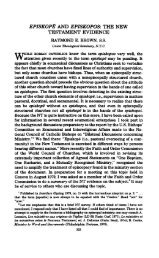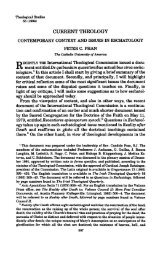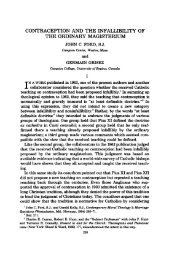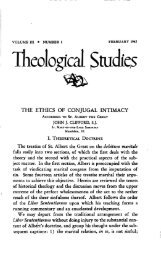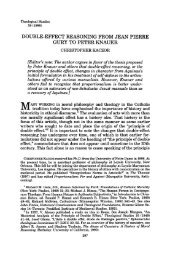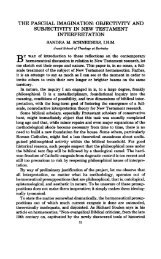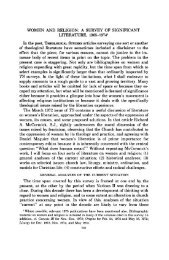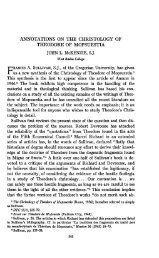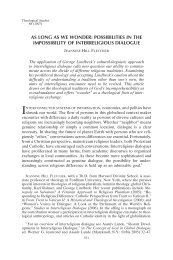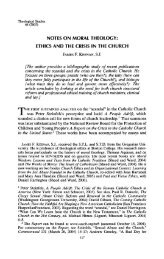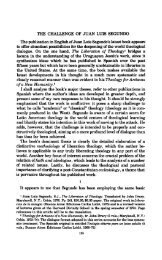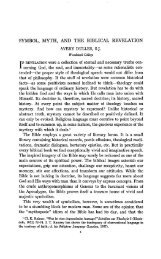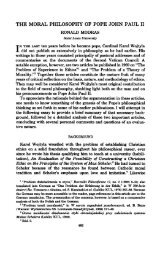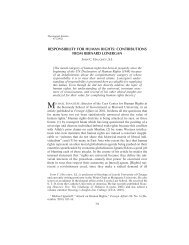from leontius of byzantium to karl barth - Theological Studies
from leontius of byzantium to karl barth - Theological Studies
from leontius of byzantium to karl barth - Theological Studies
You also want an ePaper? Increase the reach of your titles
YUMPU automatically turns print PDFs into web optimized ePapers that Google loves.
<strong>Theological</strong> <strong>Studies</strong><br />
57 (1996)<br />
A DUBIOUS CHRISTOLOGICAL FORMULA: FROM<br />
LEONTIUS OF BYZANTIUM TO KARL BARTH<br />
F. LeRON SHULTS<br />
Prince<strong>to</strong>n <strong>Theological</strong> Seminary<br />
HE DUAL FORMULA <strong>of</strong> anhypostasis-enhypostasis has become an in<br />
T creasing popular way <strong>of</strong> describing the relation <strong>of</strong> the human and<br />
divine natures <strong>of</strong> Jesus Christ. The formula aims <strong>to</strong> express the doctrine<br />
that the human nature <strong>of</strong> Jesus has no subsistence (anhypostasis)<br />
apart <strong>from</strong> the union with the Logos, but that it has its<br />
being only "in" the subsistence (en-hypostasis) <strong>of</strong> the incarnate Son <strong>of</strong><br />
God. The use <strong>of</strong> this formula is especially prevalent among theologians<br />
influenced by Karl Barth who in adopting the terms appealed <strong>to</strong> "the<br />
older dogmatics—using the language <strong>of</strong> later Greek philosophy." 1 Unfortunately,<br />
Barth's appropriation <strong>of</strong> the terms and his dialectical reconstruction<br />
<strong>of</strong> the formula are problematic in several ways, especially<br />
since in fact this is in no way the "language <strong>of</strong> later Greek philosophy^'<br />
but an invention <strong>of</strong> Protestant Scholasticism.<br />
My article argues further that this innovative usage by those Scholastics<br />
was in serious conflict with the use <strong>of</strong> terms in patristic Chris<strong>to</strong>logy,<br />
and that the uncritical acceptance <strong>of</strong> the formula by modern<br />
theologians has obfuscated the original meaning. My goal here is <strong>to</strong><br />
trace the genesis and development <strong>of</strong> these terms <strong>from</strong> Leontius <strong>of</strong><br />
Byzantium <strong>to</strong> Karl Barth in order <strong>to</strong> show the fateful moves that led <strong>to</strong><br />
a radical misreading <strong>of</strong> Leontius. What is at stake chris<strong>to</strong>logically is<br />
nothing less than the clarity <strong>of</strong> believers' confession that Jesus Christ<br />
the Lord is fully divine and fully human in one person.<br />
This modern interpretation <strong>of</strong> the Chris<strong>to</strong>logy <strong>of</strong> Leontius is centered<br />
around that sixth-century monk's alleged redefinition <strong>of</strong> the term enyposta<strong>to</strong>n<br />
(the adjectival form <strong>of</strong> hypostasis) <strong>to</strong> signify a nature that has<br />
its existence not in its own hypostasis, but in the hypostasis <strong>of</strong> another<br />
nature. Dominating scholarly opinion for over a century, this interpretation<br />
assumes that Leontius introduced a philosophical theory, with<br />
the aid <strong>of</strong> a new meaning for enyposta<strong>to</strong>n, <strong>to</strong> help explain how<br />
two natures can exist in a single hypostasis. This reading has recently<br />
been convincingly challenged through the work <strong>of</strong> two Catholic scholars,<br />
Aloys Grillmeier, S.J., and Brian E. Daley, S.J., 2 who trace<br />
1 Karl Barth, Church Dogmatics, 4 vols., trans. G. W. Bromiley and T. F. Torrance<br />
(Edinburgh: T. & T. Clark, 1936-69) IV/2.49.<br />
2 Aloys Grillmeier, S.J., "Die anthropologisch-chris<strong>to</strong>logische Sprache des Leontius<br />
von Byzanz und ihre Beziehung zu den Symmikta Zetemata des Neupla<strong>to</strong>nikers Porphyrius,"<br />
in Hermeneumata: Festschrift fur Hadwig Horner, ed. Herbert Eisenberger<br />
(Heidelberg: Carl Winter, 1990) 61-72; and "The Understanding <strong>of</strong> the Chris<strong>to</strong>logical<br />
431
432 THEOLOGICAL STUDIES<br />
the theory <strong>to</strong> the influential treatment <strong>of</strong> Leontius by Friedrich Lo<strong>of</strong>s<br />
in 1887. 3<br />
The roots <strong>of</strong> this misunderstanding about Leontius, however, appear<br />
<strong>to</strong> go back <strong>to</strong> certain Protestant Scholastics. By examining Leontius's<br />
original texts, which have never been translated fully in<strong>to</strong> English, I<br />
hope <strong>to</strong> reveal additional fallacies in the enhypostasis theory. The<br />
negative impact <strong>of</strong> this interpretation <strong>of</strong> Leontius has perhaps been<br />
stronger in Protestant theology where it continues <strong>to</strong> exert a powerful<br />
influence. For example, Bruce McCormack has recently argued that<br />
when Karl Barth adopted the anhypostasis-enhypostasis formula in<br />
1924, it "provided the material conditions needed <strong>to</strong> set free the elaboration<br />
<strong>of</strong> the analogia fidei" 4 <strong>from</strong> which his whole methodology<br />
flowed. This suggests that the misreading <strong>of</strong> Leontius, exemplified by<br />
the work <strong>of</strong> Lo<strong>of</strong>s, has deeply permeated Protestant theology and may<br />
be difficult <strong>to</strong> extricate.<br />
This article develops through six stages. After first presenting background<br />
material about Leontius, I then examine his use <strong>of</strong> the terms<br />
enyposta<strong>to</strong>n and anyposta<strong>to</strong>n in Book 3 <strong>of</strong> Contra Nes<strong>to</strong>rianos et Eutychianos,<br />
written around 540. By identifying the precise function <strong>of</strong><br />
these words in the context <strong>of</strong> the chris<strong>to</strong>logical exigency <strong>to</strong> which he<br />
was responding, I show that he was not using them in a radically new<br />
way. Next I summarize and expand upon the analyses provided by<br />
Grillmeier and Daley who were among the first <strong>to</strong> critique the modern<br />
consensus, and show that the belief that Leontius intended enyposta<strong>to</strong>n<br />
<strong>to</strong> refer <strong>to</strong> a nature that has its hypostasis in that <strong>of</strong> another nature<br />
is false. My thesis is that a common-sense translation <strong>of</strong> enyposta<strong>to</strong>n as<br />
simply "subsistent" has the advantage <strong>of</strong> reflecting the normal usage <strong>of</strong><br />
the term during the first eight centuries <strong>of</strong> Christian theology and<br />
illuminating Leontius's Chris<strong>to</strong>logy that indisputably played an important<br />
role in the post-Chalcedonian development <strong>of</strong> chris<strong>to</strong>logical<br />
doctrine. Then I trace the emergence <strong>of</strong> the terms anhypostasia and<br />
enhypostasia, which do not appear at all in Leontius or the other early<br />
Fathers <strong>to</strong> the late 16th- and 17th-century Protestant Scholastics.<br />
Definitions <strong>of</strong> Both (Oriental Orthodox and Roman Catholic) Traditions in the Light <strong>of</strong><br />
the Post-Chalcedonian Theology (Analysis <strong>of</strong> Terminologies in a Conceptual Framework),"<br />
in Christ in East and West, ed. Paul Fries and Tiran Nersoyan (Macon, Georgia:<br />
Mercer University, 1987) 65-82; Brian E. Daley, S.J., "A Richer Union: Leontius <strong>of</strong><br />
Byzantium and the Relationship <strong>of</strong> Human and Divine in Christ," in Studia Patristica 24<br />
(1993) 239-65. While I consistently transliterate the term as "enyposta<strong>to</strong>n," both Daley<br />
and Grillmeier use the traditional transliteration <strong>of</strong> enhyposta<strong>to</strong>n (with an "h"). In the<br />
adjectival form, the "n" (nu) is added <strong>to</strong> ease pronunciation, separating the epsilon <strong>from</strong><br />
the upsilon. The "h" sound disappears with the addition <strong>of</strong> the en prefix; so, in my<br />
judgment, enyposta<strong>to</strong>n is more accurate.<br />
3 Friedrich Lo<strong>of</strong>s, "Leontius von Byzanz und die gleichnamigen Schriftsteller der<br />
griechischen Kirche," in Texte und Untersuchungen 3, ed. Oskar von Gebhardt and Adolf<br />
von Harnack (Leipzig, 1887) 1-317.<br />
4 Bruce L. McCormack, Karl Barth's Critically Realistic Dialectical Theology: Its Genesis<br />
and Development 1909-1936 (Oxford: Clarendon, 1995) 19.
A DUBIOUS CHRISTOLOGICAL FORMULA 433<br />
Finally, I assess Karl Barth's dialectical appropriation <strong>of</strong> the dual<br />
chris<strong>to</strong>logical formula and explore briefly what implications this analysis<br />
has for contemporary chris<strong>to</strong>logical understanding.<br />
Before proceeding through these steps, the reader needs <strong>to</strong> keep in<br />
mind the distinction between the two positions: (1) that the human<br />
nature <strong>of</strong> Jesus does not subsist except in its union with the Logos in<br />
the one person <strong>of</strong> Christ, and (2) that enhypostasis and anhypostasis<br />
are good terms <strong>to</strong> describe this fact about the human nature <strong>of</strong> Jesus.<br />
Most <strong>of</strong> the players in this theological drama—certainly Leontius, most<br />
<strong>of</strong> the Protestant Scholastics, and Barth—do in fact affirm the first<br />
position. Although the formula under discussion has been wed <strong>to</strong> this<br />
doctrine for the last 400 years in much <strong>of</strong> Protestant theology, it is not<br />
necessary <strong>to</strong> assert the second position in order <strong>to</strong> affirm the first.<br />
Therefore, if one discovers that neither Leontius nor any other patristic<br />
writer taught the second view, this does not have <strong>to</strong> shake one's<br />
faith in the first. Rather, one simply needs <strong>to</strong> look for better ways <strong>of</strong><br />
stating that view. At the very least, those who decide <strong>to</strong> continue using<br />
the formula should be aware <strong>of</strong> the pertinent grammatical problems<br />
and the philosophical issues that shaped the original formulation. The<br />
epistemic and methodological fac<strong>to</strong>rs that led <strong>to</strong> the affirmation <strong>of</strong> the<br />
second position need <strong>to</strong> be appreciated so that any new constructive<br />
formulations will not repeat the errors <strong>of</strong> the past. The first step is <strong>to</strong><br />
understand the context <strong>of</strong> the allegedly new definitions <strong>of</strong> the terms in<br />
question.<br />
LEONTIUS OF BYZANTIUM<br />
The fact that several persons with the name Leontius were producing<br />
theological treatises in the sixth century has <strong>of</strong>ten led <strong>to</strong> confusion.<br />
5 For our purposes, it is important <strong>to</strong> note that most scholars link<br />
our Leontius, i.e., the author <strong>of</strong> Contra Nes<strong>to</strong>rianos et Eutychianos,<br />
with the Leontius <strong>of</strong> Byzantium about whom Cyril <strong>of</strong> Skythopolis wrote<br />
in his Vita Sabae. This is relevant because the latter Leontius was a<br />
Palestinian monk who lead an "Origenist" party that caused considerable<br />
political trouble, apparently even taking up garden <strong>to</strong>ols as weapons.<br />
Virtually all scholars now agree that we are dealing here with one<br />
and the same Leontius. This is enigmatic, for in what sense may our<br />
Leontius, whose Chris<strong>to</strong>logy seems <strong>to</strong> support Chalcedonian orthodoxy,<br />
be labelled an Origenist?<br />
The first person <strong>to</strong> go against the received wisdom <strong>of</strong> affirming Leontius's<br />
orthodoxy was David Evans in 1970. For Evans, the "Origenism"<br />
<strong>of</strong> our Leontius was indeed doctrinal. In order <strong>to</strong> make his case,<br />
5 In Patrologia Graeca (PG) 86, Migne mistakenly attributed Adversus Nes<strong>to</strong>rianos <strong>to</strong><br />
Leontius <strong>of</strong> Byzantium; we now know that it was written by Leontius <strong>of</strong> Jerusalem, a<br />
contemporary. For a summary <strong>of</strong> the issues in Leontian scholarship, see Brian Daley,<br />
S.J., "The Origenism <strong>of</strong> Leontius <strong>of</strong> Byzantium," Journal <strong>of</strong> <strong>Theological</strong> <strong>Studies</strong> 27 (1976)<br />
333-69.
434 THEOLOGICAL STUDIES<br />
however, Evans had <strong>to</strong> admit that Leontius never actually says anything<br />
chris<strong>to</strong>logically Origenistic, but that it is "hidden" behind the<br />
arguments. In fact, Evans posits that Leontius consciously went <strong>to</strong><br />
considerable effort <strong>to</strong> hide it so as <strong>to</strong> avoid persecution. He concludes<br />
"that the Jesus Christ <strong>of</strong> Leontius is the nous Jesus Christ [a created<br />
pre-existent being] <strong>of</strong> the Origenist Evagrius <strong>of</strong> Pontus." 6 Because <strong>of</strong><br />
Evans's exhaustive analysis and creativity, this reading held sway for<br />
a few years. But after the appearance <strong>of</strong> two articles in the mid-1970s,<br />
one finds no one defending Evans's thesis. The first article was by John<br />
J. Lynch, who argued that Leontius was in fact a Cyrillian when it<br />
came <strong>to</strong> Chris<strong>to</strong>logy, 7 an analysis based on explicit textual evidence.<br />
The second critique was provided by Brian Daley, who showed that the<br />
Origenism <strong>of</strong> monks in the sixth century was more an attitude about<br />
theology's openness <strong>to</strong> metaphysical speculation than a doctrinal system.<br />
Daley points out several areas where Leontius's Chris<strong>to</strong>logy is<br />
clearly anti-Origenistic. 8 Leontius did engage the tradition in a critical<br />
way. For example, although he follows Cyril most <strong>of</strong> the time in his<br />
attack on Nes<strong>to</strong>rius, there are some important differences <strong>of</strong> emphasis,<br />
as noted by John <strong>of</strong> Damascus two centuries later. 9 Nevertheless, Leontius<br />
clearly desired <strong>to</strong> follow the teaching <strong>of</strong> the Fathers, as one can<br />
see <strong>from</strong> his florilegium. Let us assume, then, that Leontius was not a<br />
heretic, but meant <strong>to</strong> remain in the orthodox tradition. Was his use <strong>of</strong><br />
enyposta<strong>to</strong>n radically new or was it a restatement <strong>of</strong> Chalcedon?<br />
Leontius's goal in Book 3 <strong>of</strong> Contra Nes<strong>to</strong>rianos et Eutychianos 10 was<br />
<strong>to</strong> fight the Monophysites, who were gaining strength in the sixth<br />
century without falling in<strong>to</strong> the opposite extreme <strong>of</strong> the Nes<strong>to</strong>rians. He<br />
explicitly states his purpose in the prologue: "[Since] the definition <strong>of</strong><br />
[the terms] hypostasis and ousia .. . remains confused and vague<br />
among those now counted wise, I have undertaken <strong>to</strong> elucidate and<br />
clarify [them]." 11 This is the chris<strong>to</strong>logical exigency that Leontius is<br />
addressing. A brief summary will suffice <strong>to</strong> give a sense <strong>of</strong> the argument.<br />
The book is comprised <strong>of</strong> a brief prologue, seven chapters, and an<br />
epilogue that introduces a long florilegium. Each <strong>of</strong> the seven chapters<br />
6 David Evans, Leontius <strong>of</strong> Byzantium: An Origenist Chris<strong>to</strong>logy (Washing<strong>to</strong>n:<br />
Dumbar<strong>to</strong>n Oaks, 1970) 143.<br />
7 John J. Lynch, "Leontius <strong>of</strong> Byzantium: A Cyrillian Chris<strong>to</strong>logy," <strong>Theological</strong> <strong>Studies</strong><br />
36 (1975) 455-71.<br />
8 Daley, "The Origenism <strong>of</strong> Leontius" 355-60.<br />
9 John <strong>of</strong> Damascus, De fide orthodoxa 3, chap. 3-9 (PG 94, 987B-1017B); translated<br />
as "Exposition <strong>of</strong> the Christian Faith," in Nicene and Post-Nicene Fathers, 2nd series<br />
(New York: C. Scribner's Sons, 1899) 9.47 ff.<br />
10 The title Contra Nes<strong>to</strong>rianos et Eutychianos is a misnomer; the three books that<br />
comprise the document were actually written years apart and deal with different issues.<br />
Only Book 1 extensively treats Nes<strong>to</strong>rianism and Euthychianism. My concern is only with<br />
Book 3; generic references <strong>to</strong> the title in this article refer <strong>to</strong> Book 3.<br />
11 PG 86, 1273A; translation by Evans, Leontius <strong>of</strong> Byzantium 15.
A DUBIOUS CHRISTOLOGICAL FORMULA 435<br />
begins with a dubitatio or objection set forth by Leontius's adversaries<br />
<strong>to</strong> which he then responds.<br />
THE TEACHING OF CONTRA NESTORIANOS ET EUTYCHIANOS<br />
Chapter 1 stands by itself as the first step in the argument and it is<br />
here that Leontius uses the term enyposta<strong>to</strong>n. He first asserts that<br />
both the Nes<strong>to</strong>rians and the Monophysites represented me<strong>to</strong>nymically<br />
by Eutyches share in a common fallacy. Both express the following<br />
objection: "If you posit two natures <strong>of</strong> the one Christ, but if there is no<br />
nature without hypostasis, then there will be [in him] two hypostases,<br />
<strong>to</strong>o." The task is <strong>to</strong> understand how Leontius responded <strong>to</strong> this objection,<br />
and how one should respond.<br />
However, the section in Chapter 1 that cites the term enyposta<strong>to</strong>n<br />
cannot be unders<strong>to</strong>od fully apart <strong>from</strong> the general flow <strong>of</strong> his broader<br />
argument. The next five chapters are conceptually unified by Leontius's<br />
argument that the paradigmatic analogy for understanding the<br />
two natures <strong>of</strong> Christ is the union <strong>of</strong> soul and body, introduced in the<br />
last sentence <strong>of</strong> Chapter 1. His own view <strong>of</strong> this union <strong>of</strong> body and soul<br />
is rooted in an anthropology which first divides the soul in<strong>to</strong> ousia<br />
logike and poiotes asoma<strong>to</strong>s, and then divides the latter "immaterial<br />
quality in<strong>to</strong> three faculties: appetitive, spirited and cognitive. These<br />
five chapters are Leontius' responses <strong>to</strong> further dubitationes: Chapters<br />
2—4 are against the Nes<strong>to</strong>rians (who reject this analogy), Chapters 5-6<br />
are against the Monophysites (who misrepresent it <strong>to</strong> buttress their<br />
heretical teachings).<br />
Chapter 7 stands alone as a summary and conclusion. Although<br />
Leontius formally maintains the style <strong>of</strong> dubitatio, in reality he has left<br />
it; here his enemies simply ask him <strong>to</strong> summarize the issues and his<br />
position. This he does by discussing the tropos tes henoseos. He attacks<br />
both the Nes<strong>to</strong>rian kat y axian and the Monophysite misunderstanding<br />
<strong>of</strong> hat' ousian. Leontius summarizes his analysis <strong>of</strong> being which he has<br />
developed <strong>to</strong> make comprehensible the type <strong>of</strong> union he wants <strong>to</strong> predicate<br />
<strong>of</strong> the two natures <strong>of</strong> Christ. For Leontius, all beings are defined<br />
by simultaneous modes <strong>of</strong> union and distinction. So he says there are<br />
things united by species but distinguished by hypostases (class I) and<br />
things distinguished by species but united by hypostases (class II). As<br />
Evans puts it, these can be thought <strong>of</strong> respectively as beings in their<br />
mode <strong>of</strong> nature and in their mode <strong>of</strong> union. 13 Beings <strong>of</strong> class I may be<br />
further divided in two ways: they either possess their union and distinction<br />
as simple or as composite. Second, beings <strong>of</strong> class I are in a<br />
union kat' ousian, so that one may distinguish between those that do<br />
12 1 am indebted <strong>to</strong> the analysis <strong>of</strong> Evans in the following summary.<br />
13 Evans, Leontius <strong>of</strong> Byzantium especially 33 ff. Evans introduced the terms "class I"<br />
and "class IF for easy reference.
436 THEOLOGICAL STUDIES<br />
not preserve the integrity <strong>of</strong> the definition <strong>of</strong> their being (in the union)<br />
and those that do. For Leontius, both the "Word" and the "flesh" are<br />
beings that fall in<strong>to</strong> this latter subdivision in their union kaf ousian.<br />
Other examples <strong>of</strong> the union <strong>of</strong> such beings include fire and wood in<br />
one <strong>to</strong>rch, and body and soul in one person.<br />
Our main concern is how (or whether) Leontius meant the term<br />
enyposta<strong>to</strong>n <strong>to</strong> serve as a solution <strong>to</strong> the dubitatio <strong>of</strong> the first chapter.<br />
Let us reconstruct it in the form <strong>of</strong> a syllogism. For Leontius's adversaries,<br />
the conjunction <strong>of</strong> A and B entails C.<br />
A. Jesus Christ has two natures (duo physeis epi <strong>to</strong>u henos Chris<strong>to</strong>u)<br />
B. There is no nature without hypostasis (ouk esti physis anyposta<strong>to</strong>s)<br />
C. Jesus Christ has two hypostases (duo ara an eien kai hai hypostaseis)<br />
The Monophysites avoided C by rejecting premise A, and argued instead<br />
for one nature (at least "after the union," following Eutyches).<br />
The Nes<strong>to</strong>rians boldly chose C, or at least put a division between hypostases.<br />
Leontius, on the other hand, rejected the validity <strong>of</strong> the syllogism<br />
by attacking the elliptical premise <strong>of</strong> his enemies that would be<br />
required for the entailment relation <strong>to</strong> hold, namely that two natures<br />
cannot be united in one hypostasis. This was the whole point <strong>of</strong> his<br />
extensive analysis <strong>of</strong> being, which he summarized in Chapter 7. The<br />
traditional reading <strong>of</strong> Leontius has been that the way he critiqued this<br />
elliptical premise was <strong>to</strong> give the term "enhypostasized" a new specific<br />
and nontraditional metaphysical meaning, which enabled him <strong>to</strong> avoid<br />
the heresy <strong>of</strong> C. This modern interpretation is now commonly attributed<br />
most <strong>to</strong> the influence <strong>of</strong> Friedrich Lo<strong>of</strong>s.<br />
THE MODERN INTERPRETATION OF LEONTIUS<br />
Lo<strong>of</strong>s suggested that Leontius invented the idea <strong>of</strong> something having<br />
its hypostasis not in itself, but in the hypostasis <strong>of</strong> another nature, and<br />
that this conception played a special role in the development <strong>of</strong> doctrine.<br />
This reading certainly has a prima facie tenability <strong>to</strong> it and has<br />
been accepted almost unanimously. Apart <strong>from</strong> the recent writings <strong>of</strong><br />
Grillmeier and Daley, one finds in the textbook analyses <strong>of</strong> Leontius<br />
unanimity in ascribing <strong>to</strong> him a new use <strong>of</strong> the term enyposta<strong>to</strong>n. I cite<br />
two examples. R. V. Sellers explains that Leontius responded <strong>to</strong> the<br />
enemies <strong>of</strong> orthodoxy by bringing "forward his theory <strong>of</strong> enhypostasia."<br />
14 Hans Stickelberger asserts that in describing the union <strong>of</strong> the<br />
natures in the hypostasis <strong>of</strong> the Christ Logos, Leontius "called this<br />
relation the enhypostasis <strong>of</strong> the human nature." 15 As I hope <strong>to</strong> prove,<br />
Leontius did no such thing. There are compelling reasons for rejecting<br />
the consensus view.<br />
According <strong>to</strong> Lo<strong>of</strong>s, Leontius's original contribution was the theory <strong>of</strong><br />
14 Robert Vic<strong>to</strong>r Sellers, The Council <strong>of</strong>Chalcedon (London: SPCK, 1961) 304.<br />
15 Hans Stickelberger, "Substanz und Akzidens bei Leontius von Byzanz," Theologische<br />
Zeitschrift 36 (1980) 153-61, at 159; my translation.
A DUBIOUS CHRISTOLOGICAL FORMULA 437<br />
the enhypostasia <strong>of</strong> the human nature <strong>of</strong> Christ. He argues that, for<br />
Leontius, The human nature in Christ is not anyposta<strong>to</strong>s, nor itself an<br />
hypostasis, but enyposta<strong>to</strong>s (1277D), that is, it has its hypostenai en<br />
tg logg (1944C). Lo<strong>of</strong>s here makes a connection between Leontius's<br />
use <strong>of</strong> enyposta<strong>to</strong>s in Contra Nes<strong>to</strong>rianos et Eutychianos (1277D) and a<br />
second quote <strong>from</strong> a separate text attributed <strong>to</strong> Leontius, Solutio orgumen<strong>to</strong>rum<br />
a Seuero objec<strong>to</strong>rum (1944C).<br />
However, there are several problems with the analysis by Lo<strong>of</strong>s. In<br />
Contra Nes<strong>to</strong>rianos et Eutychianos Leontius clearly does not say that<br />
the human nature is in the hypostasis <strong>of</strong> the Logos. The onus <strong>of</strong> pro<strong>of</strong><br />
rests with Lo<strong>of</strong>s. He is forced <strong>to</strong> appeal <strong>to</strong> Solutio argumen<strong>to</strong>rum, a<br />
treatise written at a different time and against a different adversary.<br />
But a closer examination <strong>of</strong> the passage he quotes invalidates his appeal.<br />
First, Lo<strong>of</strong>s changed the word order <strong>of</strong> the original text, putting<br />
hypostenai before en tg logg, <strong>to</strong> strengthen his argument (1944C). Second,<br />
he twists the grammar: the verb form is passive infinitive and<br />
does not fit his translation. To cap it <strong>of</strong>f, the text quoted by Lo<strong>of</strong>s is<br />
actually put by Leontius in the mouths <strong>of</strong> his adversaries. The context<br />
<strong>of</strong> the quote in Solutio argumen<strong>to</strong>rum a Severo objec<strong>to</strong>rum is an argument<br />
that such statements (such as en tg logg hypostenai) about the<br />
nonpreexistence <strong>of</strong> the human nature do not guarantee a single hypostasis.<br />
Therefore, Leontius wants <strong>to</strong> argue on stronger grounds for one<br />
hypostasis. The critical thing <strong>to</strong> note is that even if Leontius conceded<br />
this point <strong>to</strong> his Cyrillian interlocu<strong>to</strong>rs, this is not relevant <strong>to</strong> the<br />
crucial question <strong>of</strong> the meaning <strong>of</strong> enyposta<strong>to</strong>n, because the word enyposta<strong>to</strong>n<br />
appears nowhere in the Solutio argumen<strong>to</strong>rum passage.<br />
Finally, Lo<strong>of</strong>s misunderstands the word enyposta<strong>to</strong>n itself. As Daley<br />
notes in a recent essay, "One <strong>of</strong> Lo<strong>of</strong>s' most influential mistakes was <strong>to</strong><br />
take the word enhyposta<strong>to</strong>n ... not <strong>to</strong> mean 'hypostatic/ liaving a<br />
concrete existence,' as in fact it does, but <strong>to</strong> mean liypostasized' or<br />
'existent within 9 something else: <strong>to</strong> take the en- in the term, in other<br />
words, as a localizing prefix rather than simply the opposite <strong>of</strong> an<br />
alpha privative." 17 If enyposta<strong>to</strong>n means just "subsisting" and does not<br />
carry the metaphysical implications proposed by Lo<strong>of</strong>s, then Leontius<br />
can be seen as a creative systematizer <strong>of</strong> Chalcedon, rather than a<br />
radical innova<strong>to</strong>r or neologist.<br />
Aloys Grillmeier reached a similar conclusion: "Chalcedon speaks <strong>of</strong><br />
one hypostasis only. It seems that contrary <strong>to</strong> an 'opinio communis 9<br />
Leontius <strong>of</strong> Byzantium has not advanced much further. It was believed<br />
[wrongly] that Leontius had found another meaning <strong>of</strong> hypostasis<br />
16 Friedrich Lo<strong>of</strong>s, "Leontius von Byzanz" 65; my translation. Lo<strong>of</strong>s recognizes that<br />
Leontius would not predicate anyposta<strong>to</strong>n <strong>of</strong> the human nature <strong>of</strong> Jesus. This is important<br />
for my argument which follows. Some <strong>of</strong> the Protestant Scholastics did predicate the<br />
term <strong>of</strong> the human nature. For now, the focus is on whether Leontius predicated enyposta<strong>to</strong>n<br />
<strong>of</strong> the human nature in any special way.<br />
17 Daley, "A Richer Union" 241.
438 THEOLOGICAL STUDIES<br />
which went well beyond the one given here." 18 And more recently<br />
Grillmeier further argued ". .. that which is enhyposta<strong>to</strong>n has being<br />
and actuality in itself. Thereby it is also shown that the prefix en in the<br />
compound word enhyposta<strong>to</strong>n has been falsely interpreted. It is the<br />
opposite <strong>of</strong> an alpha priuativum (e.g. a-hyposta<strong>to</strong>n) and means precisely<br />
the possession <strong>of</strong> that property which was denied by the negation.<br />
Enhyposta<strong>to</strong>n thus means nothing other than '<strong>to</strong> have a concrete existence,'<br />
'<strong>to</strong> have actuality." 19<br />
Other Church Fathers throughout the first millennium <strong>of</strong> Christian<br />
theology used the terms enyposta<strong>to</strong>n and anyposta<strong>to</strong>n <strong>to</strong> mean simply<br />
"subsisting" and "not subsisting" respectively. A few examples <strong>of</strong> this<br />
common usage before, during, and after the time <strong>of</strong> Leontius are instructive.<br />
It is appropriate <strong>to</strong> start with the Cappadocians because they<br />
are quoted extensively as authorities in the florilegium <strong>of</strong> Contra<br />
Nes<strong>to</strong>rianos et Eutychianos. In a letter <strong>to</strong> Count Terentius, Basil <strong>of</strong><br />
Caesarea explained that because "ousia bears the same relation <strong>to</strong><br />
hypostasis as the common does <strong>to</strong> the particular it makes no sense for<br />
them <strong>to</strong> say that the Persons are without hypostasis [anypostata]" 20<br />
for <strong>of</strong> course the persons are not merely abstract essences, but truly<br />
exist. In Chapter 2 <strong>of</strong> his Oratio Catechetica, Gregory <strong>of</strong> Nyssa argued<br />
that the Word <strong>of</strong> God is not anyposta<strong>to</strong>n, i.e. not "without subsistence."<br />
21 Cyril <strong>of</strong> Jerusalem in his Catechetical Lectures (XVII, 5) refers<br />
<strong>to</strong> the Holy Spirit as "not diffused throughout the air, but having actual<br />
subsistence [enyposta<strong>to</strong>n]. 9922 Leontius <strong>of</strong> Jerusalem, a contemporary <strong>of</strong><br />
our Leontius, uses enyposta<strong>to</strong>s <strong>to</strong> mean "subsisting" in his arguments<br />
with the dyophysites; for him, all natures are enyposta<strong>to</strong>n. 23 John <strong>of</strong><br />
Damascus in the eighth century used the terms in this straightforward<br />
way in his treatment <strong>of</strong> Cyril and Leontius <strong>of</strong> Byzantium in Book 3,<br />
Chapter 9, <strong>of</strong> De fide orthodoxa. He refers directly <strong>to</strong> Leontius's argument<br />
in Chapter 1 <strong>of</strong> Contra Nes<strong>to</strong>rianos et Eutychianos, and asserts<br />
that the flesh and the Word have one and the same subsistence. Therefore,<br />
the Damascene argues, one cannot speak <strong>of</strong> either <strong>of</strong> them as<br />
anyposta<strong>to</strong>n. 24 Since Leontius was consciously trying <strong>to</strong> follow the ear-<br />
18 Grillmeier, 'The Understanding <strong>of</strong> the Chris<strong>to</strong>logical Definitions" 80.<br />
19 Grillmeier, "Die anthropologisch-chris<strong>to</strong>logische Sprache" 68-69; my translation.<br />
20 PG 32, 789A-789B; my translation. For an English translation <strong>of</strong> the full text, see<br />
Nicene and Post-Nicene Fathers, 2nd series, 8.254.<br />
21 PG 45, 17B; see Nicene and Post-Nicene Fathers, 2nd series, 5.477.<br />
22 PG 33,973A-975A; my translation. See Nicene and Post-Nicene Fathers, 2nd series,<br />
7.125, where the transla<strong>to</strong>rs render enyposta<strong>to</strong>n as "having a real substance."<br />
23 Adversus Nes<strong>to</strong>rianos, PG 86, 1561C; see Evans, Leontius 140.<br />
24 PG 94,1017A. Later in the same paragraph, he explains that "the flesh <strong>of</strong> the Word<br />
... did not have a separate hypostasis alongside the hypostasis <strong>of</strong> the Word <strong>of</strong> God, but<br />
by subsisting in it [that single hypostasis], it really did come <strong>to</strong> subsist ienyposta<strong>to</strong>sT; my<br />
translation. See Nicene and Post-Nicene Fathers, 2nd series, 9.53. Notice that this passage<br />
does not assert the equivalence <strong>of</strong> enyposta<strong>to</strong>s and "subsisting in another." The<br />
ambiguity <strong>of</strong> this text in John <strong>of</strong> Damascus makes it a possible locus (the only other<br />
likely patristic locus besides Leontius that I know <strong>of</strong>) for the Protestant Scholastic
A DUBIOUS CHRISTOLOGICAL FORMULA 439<br />
lier fathers, if he had in fact wanted <strong>to</strong> invent a new meaning for words<br />
they all used, it seems he would have been very explicit in announcing<br />
his intention. Without such an announcement, it makes more sense <strong>to</strong><br />
assume he used the terms in a way similar <strong>to</strong> other speakers <strong>of</strong> this<br />
theological language.<br />
A CLOSER LOOK AT LEONTIUS<br />
To translate the terms as used by Leontius in a common, noninnovative<br />
way does not take away <strong>from</strong> the powerful importance <strong>of</strong> his<br />
doctrinal presentation <strong>of</strong> Christ. The critical passage in Contra Nes<strong>to</strong>rianos<br />
et Eutychianos where Leontius uses the terms enyposta<strong>to</strong>n and<br />
anyposta<strong>to</strong>n has never, <strong>to</strong> my knowledge, been given a full English<br />
translation. Given the importance <strong>of</strong> this section for understanding the<br />
flaws <strong>of</strong> the enhypostasis theory, I <strong>of</strong>fer the following translation: 25<br />
A subsistence [hypostasis] and "that which subsists" [enyposta<strong>to</strong>n] are not the<br />
same, no more than a substance [ousia] and that which is substantiated [enousion]<br />
are the same. Subsistence [hypostasis] designates the particular individual,<br />
but "that which subsists" [<strong>to</strong> enyposta<strong>to</strong>n] refers <strong>to</strong> the essence. Hypostasis<br />
defines a person [prosopon] by means <strong>of</strong> particular characteristics. "That<br />
which subsists" [<strong>to</strong> enyposta<strong>to</strong>n] signifies something that is not an accident; the<br />
latter has its being in another and is not seen in itself. It is the case for all such<br />
qualities, both those called essential and those called nonessential, that they<br />
are not themselves an essence, i.e., a subsistent thing, but are perceived always<br />
in association with an essence, e.g., as cold is in a body and knowledge is<br />
in a soul. One speaks truly in saying: "there is no such thing as a nonsubsistent<br />
nature [physis anyposta<strong>to</strong>s]. n But one draws a false conclusion if one<br />
infers that a thing is a hypostasis <strong>from</strong> the assertion that it is not without<br />
subsistence [me anyposta<strong>to</strong>n]. Similarly, one can rightly say: "there is no such<br />
thing as a body without form [soma aschematis<strong>to</strong>ri]." But it would be incorrect<strong>to</strong><br />
conclude that the form is a body; rather, it is only perceived in the body.<br />
Certainly, there is no non-subsistent nature, i.e., essence. A nature, however,<br />
is not a hypostasis, for there cannot be a reversal here. A hypostasis is also a<br />
nature, but a nature is not also a hypostasis. A nature [physis] admits <strong>of</strong> the<br />
predication <strong>of</strong> "being" [einai], but a hypostasis may be further defined as that<br />
which "is by itself [katf eau<strong>to</strong>n einai]. The former indicates the character <strong>of</strong> a<br />
universal; the latter identifies a particular within a species. "Nature" designates<br />
the peculiarity <strong>of</strong> that which is held in common; hypostasis marks <strong>of</strong>f a<br />
misreading <strong>of</strong> the terms. Since the Damascene explicitly refers <strong>to</strong> Leontius <strong>of</strong> Byzantium,<br />
however, it makes sense <strong>to</strong> focus our analysis on him. Further research on the<br />
sources <strong>of</strong> the Protestant Scholastics may shed new light on the etiology <strong>of</strong> the chris<strong>to</strong>logical<br />
formula in its current dual form.<br />
25 The text is found in PG 86,1277C-1280B. Brian Daley is working on a new critical<br />
edition <strong>of</strong> all Leontius's works; see "A Richer Union" 239. In producing the translation<br />
that follows, I have compared the Migne text <strong>to</strong> a draft <strong>of</strong> Daley's currently unpublished<br />
critical edition, which he graciously provided. For a German translation (sometimes<br />
overly determined by the enhypostasis theory), see Stephan Ot<strong>to</strong>, Person und Subsistenz:<br />
Die philoosphische Anthropologic des Leontios von Byzanz. Ein Beitrag zur spatantiken<br />
Geistesgeschichte (Munich: W. Fink, 1968) 192-93.
440 THEOLOGICAL STUDIES<br />
particular <strong>from</strong> the common. To summarize: things sharing the same essence<br />
[homoousia], with a common structure <strong>of</strong> being, are properly said <strong>to</strong> be <strong>of</strong> one<br />
nature. But one can define as "hypostasis" either [A] things which share a<br />
nature but differ in number, or [B] things which are put <strong>to</strong>gether <strong>from</strong> different<br />
natures, but which share reciprocally in a common being. By "sharing being"<br />
I mean ins<strong>of</strong>ar as the nature and essence <strong>of</strong> each is perceived not by itself but<br />
only with the other, with which it has been joined and composited. It is not as<br />
if each completed the essence <strong>of</strong> the other, as in the relation between essences<br />
and things essentially predicated <strong>of</strong> them, which we call their qualities. One<br />
finds this "sharing <strong>of</strong> being" in various things, not least in the relation between<br />
soul and body, which have a common hypostasis but individual natures, each<br />
with a distinct structure <strong>of</strong> being.<br />
From this text it is clear that Lo<strong>of</strong>s's interpretation <strong>of</strong> enyposta<strong>to</strong>n as<br />
referring explicitly and only <strong>to</strong> a nature that has its subsistence or<br />
hypostasis in the hypostasis <strong>of</strong> another nature is doubly wrong. First,<br />
the term is not limited, as Lo<strong>of</strong>s apparently thought, <strong>to</strong> what I have<br />
designated as [B] cases, in which there is a union <strong>of</strong> different natures.<br />
Enyposta<strong>to</strong>n simply refers <strong>to</strong> an essence that is in fact subsisting.<br />
Second, even when it is predicated <strong>of</strong> a thing in the category <strong>of</strong> [B], the<br />
hypostasis <strong>of</strong> that nature is not in the hypostasis <strong>of</strong> another nature;<br />
rather, that nature shares a common hypostasis with the other nature.<br />
In such hypostatic unions, each individual nature maintains its own<br />
distinct structure <strong>of</strong> being (logos). The paradigm case is the union <strong>of</strong><br />
soul and body, where the natures share a common subsistence that is<br />
constituted by their relationality. Leontius naturally predicates enyposta<strong>to</strong>n<br />
<strong>of</strong> both soul and body, for each is subsistent.<br />
In fact, the translation <strong>of</strong> the terms in the normal way illustrated<br />
above also makes more sense <strong>of</strong> Leontius's internal argument. If one<br />
reads the text carefully through the lens <strong>of</strong> Lo<strong>of</strong>s, it would render<br />
Leontius a heretic. Describing the union <strong>of</strong> two natures <strong>of</strong> the type<br />
fitting the Word and the flesh, Leontius says in Chapter 7 that they are<br />
perceived "with one another and in one another." 26 Lo<strong>of</strong>s's enhypostasis<br />
theory would require that the divine nature was also in the hypostasis<br />
<strong>of</strong> the human nature. However, if Leontius was using the term<br />
enyposta<strong>to</strong>n the way everyone else did, then it would make sense <strong>to</strong><br />
predicate it <strong>of</strong> the Logos <strong>to</strong>o, because the Logos does subsist. As early<br />
as 1938, Marcel Richard recognized that for Leontius all natures (substances,<br />
ousia) are "enhypostatic," but he did not push the logic <strong>to</strong> show<br />
that this contradicts the reading by Lo<strong>of</strong>s. 27 Of course all natures are<br />
"enhypostatic'' because the latter simply means "hypostasized" or "sub-<br />
26 PG 86,1304B: met'allelon kai en allelois theoroumene. The word enyposta<strong>to</strong>n is not<br />
used in this later section <strong>of</strong> Leontius' argument. Had he intended <strong>to</strong> use it in the way<br />
Lo<strong>of</strong>s thought he did, one would have expected it <strong>to</strong> be expounded precisely here.<br />
27 Marcel Richard notes that enyposta<strong>to</strong>s is "une caract6ristique essentielle de la substance"<br />
("L&race et Pamphile," Revue des sciences philosophiques et th<strong>to</strong>logiques 27<br />
[1938] 27-52, at 33).
A DUBIOUS CHRISTOLOGICAL FORMULA 441<br />
sisting" and, given Aris<strong>to</strong>telian assumptions, a nature cannot subsist<br />
ante rem but only in rebus.<br />
Why would Lo<strong>of</strong>s make such a terminological mistake, and why was<br />
it so readily accepted and dyed in<strong>to</strong> the wool <strong>of</strong> chris<strong>to</strong>logical interpretation<br />
in modern times? The first clue is Lo<strong>of</strong>s's use <strong>of</strong> the German<br />
noun form "Enhypostasie" (the English form is enhypostasis; both<br />
translate enhypostasia) <strong>to</strong> refer <strong>to</strong> the human nature <strong>of</strong> Christ. But the<br />
word enhypostasia is not found in Contra Nes<strong>to</strong>rianos et Eutychianos.<br />
Indeed, one may search the entire corpus Leontianum for it <strong>to</strong> no avail.<br />
Leontius consistently uses the adjectival form enyposta<strong>to</strong>s and it<br />
means simply "hypostatic." Similarly, there is no such word as anhypostasia<br />
in Leontius, only the adjective anyposta<strong>to</strong>s which always<br />
means "without hypostasis" or "not hypostatic." For a nature <strong>to</strong> be<br />
enyposta<strong>to</strong>n means for it <strong>to</strong> have concrete existence; for a nature <strong>to</strong> be<br />
anyposta<strong>to</strong>n makes no sense. The latter cannot be predicated <strong>of</strong> the<br />
former since both Leontius and his adversaries held <strong>to</strong> the Aris<strong>to</strong>telian<br />
view <strong>of</strong> metaphysics.<br />
The noun form enhypostasia is found nowhere in any <strong>of</strong> the early<br />
Fathers, because it simply is not a word in their vocabulary. A search<br />
<strong>of</strong> the Thesaurus linguae graecae database shows no instances in the<br />
Greek Fathers <strong>of</strong> enypostasia or enhypostasis and only one case <strong>of</strong><br />
anypostasia. The latter is found in an obscure author within a sevenword<br />
fragment which is not even a sentence, but merely a list <strong>of</strong> words.<br />
Why then did Lo<strong>of</strong>s use the noun form <strong>to</strong> describe Leontius's theory?<br />
Had theologians in the his<strong>to</strong>ry <strong>of</strong> the Church ever utilized this term<br />
prior <strong>to</strong> Lo<strong>of</strong>s? One does find it alongside anhypostasia in the writings<br />
<strong>of</strong> some Protestant Scholastics during the late 16th and 17th centuries.<br />
ANHYPOSTASIA AND ENHYPOSTASIA EST PROTESTANT SCHOLASTICISM<br />
If the seeds <strong>of</strong> the enhypostasis theory reading <strong>of</strong> Leontius were<br />
planted during the formative period <strong>of</strong> Protestant theology and grew<br />
alongside other doctrinal developments, then eradicating the terminology<br />
<strong>of</strong> the dual formula as referring <strong>to</strong> the human nature <strong>of</strong> Jesus may<br />
be more difficult for the Lutheran and Reformed traditions than for<br />
Catholic theology. 28 The situation is even more complicated for scholarship<br />
on Barth if the formula is taken <strong>to</strong> be the material and methodological<br />
centerpiece <strong>of</strong> his whole theology.<br />
When Barth adopted these terms, he clearly thought they repre-<br />
28 Many (if not most) Catholic writers have also accepted the interpretation <strong>of</strong> Leontius<br />
as equating "enhvpostatic ,, with existing in the hypostasis <strong>of</strong> another. Piet Schoonenberg,<br />
e.g., <strong>of</strong>fers several objections <strong>to</strong> the Protestant Scholastic theories <strong>of</strong> anhypostasia<br />
(The Christ [New York: Herder and Herder, 1971] 58-65); most Catholic scholars<br />
would tend <strong>to</strong> follow him here. The only Catholic author I found who affirms the anhypostasis<br />
side <strong>of</strong> the dyad as a "classical" doctrine is John Macken, S.J., The Au<strong>to</strong>nomy<br />
Theme in the "Church Dogmatics": Karl Barth and His Critics (New York: Cambridge<br />
University, 1990) 149; for Macken's criticism <strong>of</strong> Jungel's expansion <strong>of</strong> the formula, see<br />
below.
442 THEOLOGICAL STUDIES<br />
sented ancient dogma. But they are not ancient theological terms; they<br />
are not even words in the vocabulary <strong>of</strong> the Greek Fathers. Barth <strong>to</strong>ok<br />
them <strong>from</strong> the theological textbooks <strong>of</strong> Heinrich Heppe and Heinrich<br />
Schmid who quoted the Protestant Scholastics at length. One representative<br />
text is found in the Lutheran theologian Schmid when he<br />
refers <strong>to</strong> Hollaz's summation: 'To the human nature <strong>of</strong> Christ there<br />
belong certain distinctive characteristics or prerogatives ... such are<br />
(a) anhypostasia, the being without a peculiar subsistence, since this is<br />
replaced by the divine person (hypostasis) <strong>of</strong> the Son <strong>of</strong> God, as one far<br />
more exalted." 29 Schmid then discusses Quenstedt's clarification <strong>of</strong> the<br />
distinction between "anhypostasia and enhypostasia." Finally, he<br />
quotes Gerhard: "Relatively, that is said <strong>to</strong> be anhyposta<strong>to</strong>n, which<br />
does not subsist in its own, but in the hypostasis <strong>of</strong> another.... In this<br />
sense, the flesh <strong>of</strong> Christ is said <strong>to</strong> be anhyposta<strong>to</strong>s, because it is enhyposta<strong>to</strong>s,<br />
subsisting in the logos." 30<br />
Apparently Lutheran Scholastics created the terms anhypostasia<br />
and enhypostasia since they appear in this noun form for the first time<br />
here. Two things are important <strong>to</strong> note. First, it would be true <strong>to</strong> their<br />
sensibilities <strong>to</strong> turn the adjectival forms <strong>of</strong> enyposta<strong>to</strong>s and anyposta<strong>to</strong>s<br />
in<strong>to</strong> nouns. Perhaps the Lutheran Scholastics were influenced here by<br />
the nominalism <strong>of</strong> William <strong>of</strong> Ockham. With a tendency <strong>to</strong> eschew the<br />
whole discussion <strong>of</strong> universals and particulars, natures and hypostases,<br />
they may have preferred simply <strong>to</strong> point at a concrete entity (like<br />
the humanity <strong>of</strong> Jesus) and name it something concrete (like enhypostasia).<br />
This move may have even tacitly provided latent support for the<br />
Lutheran inclusion <strong>of</strong> the genus maiestaticum in the doctrinal debates<br />
over communicatio idiomatum. Second, whatever the motivation for<br />
the introduction <strong>of</strong> the terms, they have no basis in the patristic literature.<br />
I have also shown that even if enhypostasia had been a word<br />
in the early Church, it would not have described a nature that has its<br />
existence in the hypostasis <strong>of</strong> another nature.<br />
What about anhypostasia! Here the case against the Lutheran Scholastic<br />
usage is even stronger. Lo<strong>of</strong>s himself recognized that Leontius<br />
referred <strong>to</strong> the flesh <strong>of</strong> Christ as "not anyposta<strong>to</strong>n." But the Scholastics<br />
quoted above said that the human nature is anhypostasia. Even if the<br />
latter were in fact a word, this would amount <strong>to</strong> saying that the flesh<br />
<strong>of</strong> Jesus "is isn't," which makes no sense. Both Leontius and the Lutherans<br />
want <strong>to</strong> affirm what I have called in my introduc<strong>to</strong>ry remarks<br />
the first position, namely that the human nature <strong>of</strong> Jesus does not<br />
have an independent subsistence outside the union with the Logos.<br />
Leontius would never have supported the second position, namely that<br />
the terms anhypostasis and enhypostasis are appropriate terms <strong>to</strong> express<br />
this chris<strong>to</strong>logical doctrine.<br />
29 Heinrich Schmid, The Doctrinal Theology <strong>of</strong> the Evangelical Lutheran Church (Minneapolis:<br />
Augsburg, 1875) 300.<br />
30 Ibid. 301.
A DUBIOUS CHRISTOLOGICAL FORMULA 443<br />
Although the Reformed Scholastics apparently never actually used<br />
the noun form <strong>of</strong> these terms, they nevertheless misunders<strong>to</strong>od the<br />
adjectival forms and utilized them in a similar way. Here are two<br />
representative Scholastic texts quoted in Heppe. The first is <strong>from</strong> the<br />
Leiden Synopsis: "... the Son <strong>of</strong> God, the second eternal person <strong>of</strong> the<br />
sacrosanct Trinity, assumed in<strong>to</strong> the unity <strong>of</strong> his person right <strong>from</strong> the<br />
moment <strong>of</strong> conception not a pre-existent person but one anhyposta<strong>to</strong>s<br />
<strong>of</strong> its own hypostasis or devoid <strong>of</strong> subsistence, and made it belong <strong>to</strong><br />
himself. [The flesh] subsists in him and is borne and supported by<br />
him." 31 The second quote is <strong>from</strong> Heidegger: "Assuredly there must <strong>of</strong><br />
necessity be one hypostasis, one subsistent person. Either the divine<br />
nature subsists in the human, or the human in the divine. That the<br />
divine nature should subsist in and be sustained by the human is<br />
opposed <strong>to</strong> its infinite perfection. So the human is per se anhyposta<strong>to</strong>s<br />
and becomes enhyposta<strong>to</strong>s in the logos, who being pre-existent, in fact<br />
existent <strong>from</strong> eternity, has received in time the form <strong>of</strong> a servant... as<br />
its shrine and instrument." 32 Lo<strong>of</strong>s, and virtually everyone else,<br />
adopted this way <strong>of</strong> transliterating the terms (i.e. including the "h"),<br />
which has had the negative effect <strong>of</strong> making even the adjectival forms<br />
look like nouns. One must conclude that these Protestant Scholastics<br />
misappropriated the terms and employed them in a way contradic<strong>to</strong>ry<br />
<strong>to</strong> their use by Leontius and the other Greek Fathers.<br />
THE ANHYPOSTASIS-ENHYPOSTASIS FORMULA IN KARL BARTH<br />
I have already alluded <strong>to</strong> the fact that the effects <strong>of</strong> this interpretation<br />
did not s<strong>to</strong>p with the Scholastics. Its ramifications have been<br />
particularly evident in the theology <strong>of</strong> Karl Barth and his followers. In<br />
his Church Dogmatics Barth calls the dual formula <strong>of</strong> anhypostasis<br />
and enhypostasis "the sum and root <strong>of</strong> all the grace addressed <strong>to</strong> him,"<br />
i.e., <strong>to</strong> the human nature <strong>of</strong> Jesus Christ. 33 While he intended <strong>to</strong> represent<br />
faithfully their teaching, Barth's use <strong>of</strong> dialectic reshaped the<br />
dual formula beyond its character in the Scholastics. He discussed the<br />
terms in more detail in the second volume on the Word <strong>of</strong> God:<br />
Anhypostasis asserts the negative. Since in virtue <strong>of</strong> the egene<strong>to</strong>, i.e., in virtue<br />
<strong>of</strong> the assumptio, Christ's human nature has its existence—the ancients said,<br />
its subsistence—in the existence <strong>of</strong> God, meaning in the mode <strong>of</strong> being {hypostasis,<br />
"person") <strong>of</strong> the Word, it does not possess it in and for itself, in abstrac<strong>to</strong>.<br />
Apart <strong>from</strong> the divine mode <strong>of</strong> being whose existence it acquires it has none <strong>of</strong><br />
its own; i.e., apart <strong>from</strong> its concrete existence in God in the event <strong>of</strong> the unio,<br />
it has no existence <strong>of</strong> its own, it is anhyposta<strong>to</strong>s. Enhypostasis asserts the<br />
positive. In virtue <strong>of</strong> the egene<strong>to</strong>, i.e., in virtue <strong>of</strong> the assumptio, the human<br />
nature acquires existence (subsistence) in the existence <strong>of</strong> God, meaning in the<br />
mode <strong>of</strong> being (hypostasis, "person") <strong>of</strong> the Word. This divine mode <strong>of</strong> being<br />
31<br />
Heinrich Heppe, Reformed Dogmatics, revised edition, ed. Ernst Bizer, trans. G. T.<br />
Thomson (London: George Allen and Unwin, 1950) 418.<br />
32 33<br />
Ibid. 428.<br />
Barth, Dogmatics IV/2.91.
444 THEOLOGICAL STUDIES<br />
gives it existence in the event <strong>of</strong> the unio, and in this way it has a concrete<br />
existence <strong>of</strong> its own, it is enhyposta<strong>to</strong>s. 34<br />
T. F. Torrance, co-edi<strong>to</strong>r <strong>of</strong> the English translation <strong>of</strong> Barth's Church<br />
Dogmatics, followed him in this dialectical usage <strong>of</strong> these terms <strong>to</strong><br />
express the relation <strong>of</strong> the two natures <strong>of</strong> Jesus Christ. However, Torrance<br />
went beyond Barth and pressed the dual formula in<strong>to</strong> further<br />
service. Explaining the "logic <strong>of</strong> God," which is revealed in the nature<br />
<strong>of</strong> the incarnate Logos, Torrance argued that "the logic <strong>of</strong> Grace and<br />
the logic <strong>of</strong> Christ [the two sides <strong>of</strong> the logic <strong>of</strong> God] are <strong>to</strong> be related <strong>to</strong><br />
one another as the doctrines <strong>of</strong> anhypostasia and enhypostasia." 35 In<br />
the context <strong>of</strong> theological thinking, the former posited the unconditional<br />
priority <strong>of</strong> grace, while the latter affirmed an unimpaired place<br />
for human response. Holding these two <strong>to</strong>gether, Torrance suggested,<br />
is necessary for "thinking out the interior logic <strong>of</strong> theological<br />
thought." 36 My analysis <strong>of</strong> the terms enyposta<strong>to</strong>s and anyposta<strong>to</strong>s in<br />
this article should at least cause one <strong>to</strong> pause and consider whether<br />
invoking the dual formula is the best way <strong>of</strong> accomplishing Torrance's<br />
goal <strong>of</strong> describing the logic <strong>of</strong> theology.<br />
Eberhard Jiingel echoes Barth by incorrectly referring <strong>to</strong> enhypostasis<br />
and anhypostasis as a "patristic doctrine." 37 Like Torrance, he<br />
expands the scope <strong>of</strong> the formula, arguing that it might also be operative<br />
implicitly in Barth's doctrine <strong>of</strong> election. Interestingly, Jiingel <strong>of</strong>fers<br />
an anonymous Greek phrase—enyposta<strong>to</strong>s tg logg <strong>to</strong>u theou—<strong>to</strong><br />
clarify his argument. 38 Although he gives no reference for this quote, it<br />
is certainly reminiscent <strong>of</strong> the misquoting <strong>of</strong> Leontius by Lo<strong>of</strong>s, which<br />
has been analyzed above. Jiingel even calls for a new formulation <strong>of</strong> the<br />
doctrine <strong>of</strong> God in these terms: "God's being ad extra would be anhypostatic<br />
if in this relation an enhypostasis <strong>of</strong> the being <strong>of</strong> God as Father,<br />
as Son and as Spirit was not fulfilled." 39 John Macken, S.J.,<br />
traced Jungel's further application <strong>of</strong> the formula <strong>to</strong> the issue <strong>of</strong> the<br />
au<strong>to</strong>nomy and heteronomy <strong>of</strong> the human self in relation <strong>to</strong> Christ.<br />
Macken apparently accepted Barth's application <strong>of</strong> the formula <strong>to</strong><br />
Christ, but found Jungel's expansion <strong>of</strong> the formula <strong>to</strong> the Christian<br />
life <strong>to</strong>o restrictive for a sound distinction between nature and grace. 40<br />
These authors treat the anhypostasis-enhypostasis formula as a<br />
single motif in Barth's thought. Bruce McCormack, on the other hand,<br />
has argued more strongly than in Barth's 1924 Gottingen Dogmatics<br />
"the anhypostatic-enhypostatic model had supplanted the timeeternity<br />
dialectic as the central parable for expressing the Realdia-<br />
34<br />
Ibid. 1/2.163.<br />
35 T F Torrance, <strong>Theological</strong> Science (London: Oxford University, 1969) 217.<br />
36<br />
Ibid. 218.<br />
37<br />
Eberhard Jiingel, The Doctrine <strong>of</strong> the Trinity: God's Being Is in Becoming (Grand<br />
Rapids: Eerdmans, 1976) 98.<br />
38 39<br />
Ibid. 81, 98.<br />
Ibid. 104.<br />
40<br />
Macken, The Au<strong>to</strong>nomy Theme in the "Church Dogmatics" 168.
A DUBIOUS CHRISTOLOGICAL FORMULA 445<br />
lektik <strong>of</strong> God's veiling and unveiling," 41 and that the adoption <strong>of</strong> this<br />
formula marked the beginning <strong>of</strong> a new phase in his theology that<br />
continued through the Church Dogmatics. It makes sense <strong>to</strong> think that<br />
Barth made a theological decision <strong>to</strong> root dogmatics in the Incarnation<br />
in 1924, as McCormack suggests. But it is less clear that the anhypostasis-enhypostasis<br />
formula became the central parable for pointing <strong>to</strong><br />
the Realdialektik because, as Barth himself recognized both in the<br />
Gottingen Dogmatics and in the Church Dogmatics, the referent <strong>of</strong><br />
these terms is not God but the human nature <strong>of</strong> Jesus. 42 One might<br />
expect a parable that aims <strong>to</strong> replace the "time-eternity" dialectic <strong>to</strong><br />
reach beyond the predicates <strong>of</strong> the human nature <strong>of</strong> Jesus. To find such<br />
a parable, one might explore, for example, the broader arena <strong>of</strong> God's<br />
revelation "in Christ," which includes for Barth not only Word but also<br />
Spirit, not only the objective but also the subjective reality <strong>of</strong> God's<br />
self-revelation. Here <strong>to</strong>o one can find at least the seeds <strong>of</strong> other<br />
parables in Parts 5-7 <strong>of</strong> the Gottingen Dogmatics.<br />
Despite the fact that Barth refers <strong>to</strong> the formula only three or four<br />
times in 1/2 and IV/2, it was clearly important for him. This tw<strong>of</strong>old<br />
doctrine, which he incorrectly thought was "unanimously sponsored by<br />
early theology in its entirety," 43 is not a superfluous theologoumenon:<br />
"this concept [anhypostasis-enhypostasis] is quite unavoidable at this<br />
point if we are properly <strong>to</strong> describe the mystery." 44 My preceding<br />
analysis <strong>of</strong> the formula suggests that those who desire <strong>to</strong> join Barth in<br />
affirming the importance <strong>of</strong> the concept should make an explicit and<br />
careful distinction between the concept and the contingency <strong>of</strong> the<br />
dyad which has come <strong>to</strong> express it. In any case, by arguing that the<br />
dual formula is not necessarily the central parable, and that these<br />
terms are not necessary for expressing Barth's view <strong>of</strong> the Realdialektik,<br />
one may reject the Protestant Scholastic terminology and its<br />
problems without simultaneously rejecting Barth's contributions <strong>to</strong><br />
the doctrine <strong>of</strong> revelation.<br />
The later Barth referred <strong>to</strong> the Church as anhypostasis and enhypostasis<br />
in relation <strong>to</strong> Christ, 45 and without using the terms he applied<br />
a similar structural apparatus <strong>to</strong> the experience <strong>of</strong> awakening <strong>to</strong> conversion<br />
in the individual Christian as well. 46 The individual is not a<br />
new man outside the regenerative activity <strong>of</strong> the divine Spirit, but is a<br />
41 McCormack, Karl Barth's Critically Realistic Dialectical Theology 367. McCormack<br />
suggests that Barth's use <strong>of</strong> the model was "thoroughly Reformed" (371). However, Barth<br />
seems <strong>to</strong> follow the Lutherans quoted by Schmid in adopting the noun forms rather than<br />
limiting himself <strong>to</strong> the adjectives as in the Reformed Scholastics quoted by Heppe. Barth<br />
wrote the preface <strong>to</strong> the Bizer edition <strong>of</strong> Heppe's book—there he confesses <strong>to</strong> a heavy<br />
reliance on both Heppe and Schmid in preparing the Gottingen Dogmatics. Barth treats<br />
the dual formula in the Gottingen Dogmatics, trans. G. W. Bromiley (Grand Rapids:<br />
Eerdmans, 1991) 157.<br />
42 Barth, Dogmatics, IV/2.91; Gottingen Dogmatics, 157.<br />
43 Ibid. 1/2.163. ** Ibid. IV/2.50.<br />
45 Ibid. IV/2.59. ** Ibid. IV/2.557-63.
446 THEOLOGICAL STUDIES<br />
new man through that activity. What seems most important <strong>to</strong> Barth<br />
is not the terms, but a specific kind <strong>of</strong> relational unity that maintains<br />
the asymmetry <strong>of</strong> the divine initiative. This suggests that for Barth the<br />
critical issue is not the anhypostasis-enhypostasis formula, but an insistence<br />
on the creature's <strong>to</strong>tal reliance on God's grace.<br />
CONCLUSION<br />
I conclude by stressing again the importance <strong>of</strong> distinguishing the<br />
following statements: (1) that the human nature <strong>of</strong> Jesus does not<br />
subsist except in its union with the Logos in the one Person <strong>of</strong> Christ,<br />
and (2) that enhypostasis and anhypostasis are good terms <strong>to</strong> describe<br />
this fact about the human nature <strong>of</strong> Jesus. If one is compelled <strong>to</strong> reject<br />
the second thesis, and the use <strong>of</strong> the formula in the way meant by the<br />
Protestant Scholastics, Lo<strong>of</strong>s, and Barth, this does not mean that one<br />
rejects what they were trying <strong>to</strong> express by using those terms, namely,<br />
the first thesis. Instead, one needs <strong>to</strong> search for better ways <strong>to</strong> state the<br />
mystery <strong>of</strong> the relation between the Logos and the flesh in Jesus<br />
Christ. What is at issue is the clarity <strong>of</strong> one's confession that the Lord<br />
is fully divine and fully human in one Person.<br />
A final implication that may be drawn <strong>from</strong> this analysis is the<br />
importance <strong>of</strong> recognizing how powerfully theological anthropology<br />
shapes Chris<strong>to</strong>logy. For Leontius, the paradigmatic analogy for the<br />
relational unity <strong>of</strong> the Word and the flesh in Jesus Christ was the<br />
relational unity <strong>of</strong> soul and body in a human person. For the Lutheran<br />
Scholastics, it appears that the nominalist avoidance <strong>of</strong> speaking <strong>of</strong> a<br />
universal human nature led them <strong>to</strong> misinterpret the terms enyposta<strong>to</strong>n<br />
and anyposta<strong>to</strong>n. Barth's tendency, in his polemic against analogia<br />
entis, <strong>to</strong> eschew speculative anthropology <strong>of</strong> any kind, led <strong>to</strong> such a<br />
strong emphasis in his theological method on the transcendent that he<br />
was accused <strong>of</strong> revelational positivism. While it would be reductionistic<br />
<strong>to</strong> suggest a causal determinism in the relation <strong>of</strong> anthropology and<br />
Chris<strong>to</strong>logy, one cannot deny that there is a reciprocal influence between<br />
them. The importance <strong>of</strong> the nature and quality <strong>of</strong> relationality<br />
in both doctrines should also lead theologians <strong>to</strong> make explicit their<br />
underlying presuppositions about epistemic and ontic relational structures<br />
in all anthropological and chris<strong>to</strong>logical reflection.



